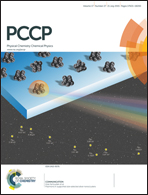First-principles assessment of hole transport in pure and Li-doped NiO†
Abstract
Alloying nickel oxide (NiO) with lithium oxide (Li2O) at high Li concentrations may reduce NiO's band gap and expand its use as a light absorber in photocatalytic and tandem dye-sensitized solar cell technologies. In this work, we evaluate the viability of this alloy as a p-type hole transport material. We use embedded cluster models, along with unrestricted Hartree–Fock and complete active space self-consistent field theories, to study the impact of alloying on polaronic transport of holes. Our calculated energy barrier for hole transfer in undoped NiO is in excellent agreement with the experimental value of ∼0.1 eV. We predict that hole transport in NiO is anisotropic and mostly confined parallel to the (111) ferromagnetic planes. Applying the same model to Li-doped NiO indicates that isolated Li ions do not introduce free holes into NiO samples. However, free holes can be created in the homogeneous Li0.125Ni0.875O alloy, in which the Li concentration is very high. Our kinetic Monte Carlo calculations show that hole mobility in this alloy is lower than in undoped NiO. However, the additional free holes and the predicted lower band gap of Li0.125Ni0.875O should increase hole conductivity compared to NiO upon alloy formation. Therefore, Li0.125Ni0.875O alloys have potential for use as a hole transporter, as well as a sunlight absorber, in a variety of solar energy applications.


 Please wait while we load your content...
Please wait while we load your content...